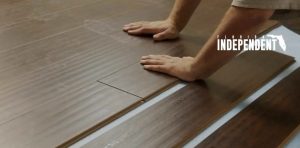What kind of Flooring is Utilized in Commercial Structures?


When you are planning to install new floors in your commercial building, you should know about the different types of flooring available in the market. These include Vinyl composite tile, Carpet, and Epoxy coatings. The first type of flooring is Vinyl flooring, which comes in wide sheets, allowing you to eliminate seams. It is cheaper than VCT, but it sacrifices durability in favor of flexibility. Another advantage is that it holds finishes nicely. However, its disadvantages include the fact that it requires more maintenance and requires stripping.
Hardwood flooring
Commercial buildings often require wood flooring that can stand up to higher amounts of moisture. This means that commercial floors need more stable wood than residential ones. While hardwood is prone to expanding and contracting with water, engineered wood is more durable and can stand up to more significant quantities of moisture. Hardwood floors for commercial buildings also require less cleaning than residential floors. These floors can be easily cleaned with specialized detergents.
Hardwood floors in commercial buildings must be sturdy and able to withstand heavy traffic. As a rule of thumb, commercial flooring can be refinished up to 10 times before wearing out. The amount of refinishing required is dependent on the type of hardwood and the level of wear and tear.
Vinyl composite tile
Vinyl composite tile (VCT) is the most popular flooring option for educational and medical facilities. Its low initial cost and wide range of color options make it a practical choice for high-traffic areas. Its durability also makes it an excellent opportunity for office and medical buildings with large floor areas. Whether in a school, office, hospital, or medical facility, VCT floors can provide a professional feel in high-traffic areas.
Another significant advantage of vinyl composite tile flooring is its ease of installation. It can be laid directly over a concrete floor without the use of a pad. This dramatically simplifies the installation process and can result in lower labor costs.
Carpet
There are two main types of carpets for commercial buildings: broadloom and modular Carpets. Broadloom is the most traditional style of Carpet for commercial buildings and is typically installed in a continuous fashion across the floor. Modular Carpet is another popular option, which is durable and easy to install and replace. Modular Carpet comes in small squares that are installed side by side for a smooth carpet finish.
Commercial Carpet is often higher-density and more durable than residential Carpet. Residential Carpets can fade and discolor in areas with heavy traffic, but commercial-grade carpets will last longer. Moreover, many buildings have specific aesthetic requirements. For instance, a hotel may want large-scale, ornate patterns. Hotel carpets are usually rolled. Corporate offices, on the other hand, may want to install carpet tiles in order to provide access to under-floor data cabling. Fortunately, commercial-grade Carpets can accommodate a variety of needs, including these.
Epoxy coatings
Epoxy coatings are used in many commercial buildings for a number of reasons. They are durable, and they can withstand a wide range of chemical cleaning products. It is instrumental in hospitals and restaurants where a lot of chemicals are spilled. It was also suitable for commercial kitchens and showrooms.
These coatings are typically applied in one or two coats. They are applied using a roller or squeegee. A thicker layer will reduce defects and increase the durability of the finished surface. Many EFCs require 24-48 hours of curing time between coats, but this can vary depending on the application method and site conditions.
Carpet tiles
The main advantage of carpet tiles is that they are easy to install, and you can replace them quickly as needed. Unlike broadloom, which is installed wall-to-wall, tiles can be removed and replaced individually. This helps minimize waste. Additionally, you can reuse old tiles for other areas of your building.
While the carpet-tile look has always been popular in homes, recent developments in technology have allowed for more exciting patterns and colors. Although boxy-shaped tiles are still a mainstay, other geometric shapes and designs are increasingly popular in offices and commercial buildings. In addition, carpet tiles are effortless to transport, store, and handle.
Broadloom Carpet
Broadloom is a common type of Carpet used in commercial buildings. These carpets come in rolls that are typically 12 feet wide. They can also be more extensive, at up to 15 feet wide. Usually, broadloom is sold by the square yard, but it can also be sold by the square meter in countries that use the metric system. In Canada, however, the floor-covering industry still primarily uses imperial measurements.
There are several different types of carpeting used in commercial buildings. The main differences between them are the style and the color. Broadloom Carpet is known for its soft, cushioning feel and is an excellent choice for commercial settings. However, it is essential to consider how the space will be designed before selecting the right kind of Carpet for your building.
